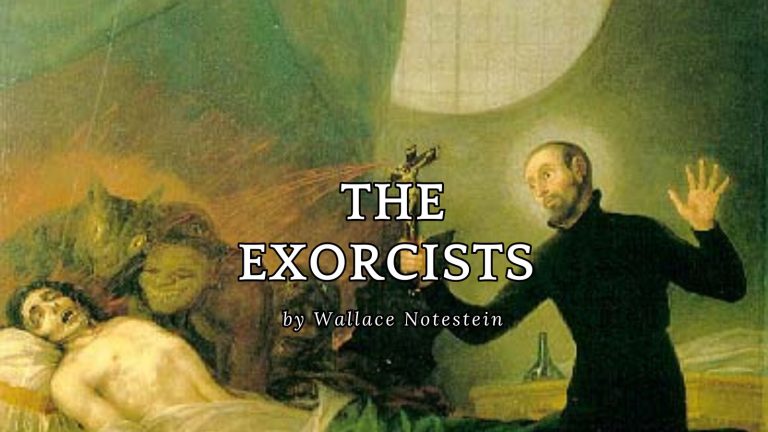WERWOLVES AND VAMPIRES AND GHOULS
from Werwolves (1912)
by Elliott O’Donnell
 THROUGHOUT the Middle Ages, and even in the seventeenth century, trials for lycanthropy were of common occurrence in France. Among the most famous were those of the Grandillon family in the Jura, in 1598; that of the tailor of Châlons; of Roulet, in Angers; of Gilles Garnier, in Dôle, in 1573; and of Jean Garnier, at Bordeaux, in 1603. The last case was, perhaps, the most remarkable of all. Garnier, who was only fourteen years of age, was employed in looking after cattle. He was a handsome lad, with dark, flashing eyes and very white teeth. As soon as it was time for the metamorphosis to take place he used to go into some lonely spot, and then, in the guise of a wolf, return, and run to earth isolated women and children. One of his favourite haunts was a thicket close to a pool of water. Here he used to lie and watch for hours at a time. Once he surprised two girls bathing. One escaped, and fled home naked, but the other he flung on the ground, and having shaken her into submission, devoured a portion of her one day, and the rest of her the next. He confessed to having eaten over fifty children. Nor did he always confine himself to attacking the solitary few and defenceless; for on several occasions, when hard pressed by hunger, he assailed a whole crowd, and was once severely handled by a pack of young girls who successfully drove him off with sharply pointed stakes. Far from wishing to conceal his guilt, Jean Garnier was most eager to tell everything, and to a court thronged with eager, attentive people, he related in the most graphic manner possible his sanguinary experiences. One old woman, he said, whom he found alone in a cottage, showed extraordinary agility in trying to escape. She raced round tables, clambered over chairs, crawled under a bed, and finally hid in a cupboard and held the door so fast that he had to exert all his force to open it. “And then,” he added, “in spite of all my trouble she proved to be as tough as leather——” and he made a grimace that provoked much laughter.
THROUGHOUT the Middle Ages, and even in the seventeenth century, trials for lycanthropy were of common occurrence in France. Among the most famous were those of the Grandillon family in the Jura, in 1598; that of the tailor of Châlons; of Roulet, in Angers; of Gilles Garnier, in Dôle, in 1573; and of Jean Garnier, at Bordeaux, in 1603. The last case was, perhaps, the most remarkable of all. Garnier, who was only fourteen years of age, was employed in looking after cattle. He was a handsome lad, with dark, flashing eyes and very white teeth. As soon as it was time for the metamorphosis to take place he used to go into some lonely spot, and then, in the guise of a wolf, return, and run to earth isolated women and children. One of his favourite haunts was a thicket close to a pool of water. Here he used to lie and watch for hours at a time. Once he surprised two girls bathing. One escaped, and fled home naked, but the other he flung on the ground, and having shaken her into submission, devoured a portion of her one day, and the rest of her the next. He confessed to having eaten over fifty children. Nor did he always confine himself to attacking the solitary few and defenceless; for on several occasions, when hard pressed by hunger, he assailed a whole crowd, and was once severely handled by a pack of young girls who successfully drove him off with sharply pointed stakes. Far from wishing to conceal his guilt, Jean Garnier was most eager to tell everything, and to a court thronged with eager, attentive people, he related in the most graphic manner possible his sanguinary experiences. One old woman, he said, whom he found alone in a cottage, showed extraordinary agility in trying to escape. She raced round tables, clambered over chairs, crawled under a bed, and finally hid in a cupboard and held the door so fast that he had to exert all his force to open it. “And then,” he added, “in spite of all my trouble she proved to be as tough as leather——” and he made a grimace that provoked much laughter.
He complained bitterly of one child. “It made such a dreadful noise,” he said, “when I lifted it out of its crib, and when I got ready for my first bite it shrieked so loud it almost deafened me.”
The name Grénier, like that of Garnier, was closely associated with lycanthropy, and in Blois, where there were more instances of lycanthropy than in any other part of France, every one called Grénier or Garnier was set down as a werwolf.
Amongst the Vaudois lycanthropy was also widely prevalent, and many of these werwolves were brought to trial and executed.
The Case of Sergeant Bertrand
The case of Sergeant Bertrand, which is the last authenticated case of this kind, occurred in 1847, when, on the 10th of July, an investigation was held before a military council presided over by Colonel Manselon. For some months the cemeteries in and around Paris had been the scenes of frightful violations, the culprits (or culprit), in some extraordinary manner, eluding every attempt made to ensnare them. At one time the custodians of the cemeteries were suspected, then the local police, and for a brief space suspicion fell even on the relations of the dead. The first burial-place to be so mysteriously visited was the Cemetery of Père Lachaise. Here, at night, those in charge declared they saw a strange form, partly human and partly animal, glide about from tomb to tomb. Try how they would they could not catch it—it always vanished—vanished just like a phantom directly they came up to it; and the dogs when urged to seize it would only bark and howl, and show indications of the most abject terror.
Always when morning broke the ravages of this unsavoury visitant were only too plainly visible—graves had been dug up, coffins burst open, and the contents nibbled, and gnawed, and scattered all over the ground. Expert medical opinion was sought, but with no fresh result. The doctors, too, were agreed that the mutilations of the dead were produced by the bites of what certainly seemed to be human teeth.
The sensation caused by this announcement was without parallel; and one and all, old and young, rich and poor, were wanting to know whatever sort of being it could be that possessed so foul an appetite. The watch was doubled; all to no purpose. A young soldier was arrested, but on declaring he had merely entered the cemetery to meet a friend, and exhibiting no evidences of guilt, was let go.
At length the violation ceased in Père Lachaise and broke out elsewhere. A little girl, greatly beloved by her relatives and friends, died, and a big concourse of people attended the funeral. On the following morning, to the intense indignation of every one, the grave was discovered dug up, the coffin forced open, and the body half eaten. In its wild fury at such an unheard-of atrocity the public called loudly for the culprit. The father of the dead girl was first of all arrested, but his innocence being quickly established, he was set free. Every means was then taken to guard against any recurrence, but in spite of all precautions the same thing happened again shortly afterwards; and happened repeatedly. The fact that the cemetery was surrounded by very high walls, and that iron gates, which were always kept shut, formed the only legitimate entrance, added to the mystery, and made it seem impossible that any creature of solid flesh and blood could be responsible for the outrages.
Having observed that at one place, in particular, the wall, though nearly ten feet high, showed signs of having been frequently scaled, an old army officer set a trap there, consisting of a wire connected with an explosive, which was so arranged that no one could climb over the wall without treading on the wire and causing an explosion.
A strong posse of detectives kept watch, and at midnight a loud report was heard. The detectives were not, however, as quick as their quarry. They saw a man, or what they took to be a man, and fired at him, but he was gone like a flash of lightning, scaling the wall with the agility of a monkey. Finding a trail of blood, however, and pieces of torn uniform accompanying the bloodstains, they concluded that the enemy was wounded, and that the marauder was, moreover, a soldier.
Still, it is doubtful whether his identity would have been proved, had not one of the grave-diggers of the cemetery chanced to overhear some sappers of the 74th Regiment remark that on the preceding night one of their comrades—a sergeant—had been conveyed to the military hospital of Val de Grâce badly wounded. The matter was at once inquired into, and the wounded soldier, Sergeant Bertrand, was found to be the author of the long series of hideous violations. Bertrand freely confessed his guilt, declaring that he was driven to it against his own will by some external force he could not define, and which allowed him no peace. He had, he said, in one night exhumed and bitten as many as fifteen bodies. He employed no implements, but tore up the soil after the manner of a wild beast, paying no heed to the bruising and laceration of his hands so long as he could get at the dead. He could not describe what his sensations were like when he was thus occupied; he only knew that he was not himself but some ravenous, ferocious animal. He added, that after these nocturnal expeditions he invariably fell into a profound sleep, often before he could get home, and that always, during that sleep, he was conscious of undergoing peculiar metamorphosis. When interrogated, he informed the court of inquiry that, as a child, he preferred the company of all kinds of animals to that of his fellow creatures, and that in order to get in close touch with his four-footed friends he used to frequent the most solitary and out-of-the-way places—moors, woods, and deserts. He said that it was immediately after one of these excursions that he first experienced the sensation of undergoing some great change in his sleep, and that the following evening, when passing close to a cemetery where the grave-diggers were covering a body that had just been interred, yielding to a sudden impulse, he crept in and watched them. A sharp shower of rain interrupting their labours, they went away, leaving their task unfinished. “At the sight of the coffin,” Bertrand said, “horrible desires seized me; my head throbbed, my heart palpitated, and had it not been for the timely arrival of friends I should have then and there yielded to my inclinations. From that time forth I was never free—these terrible cravings invariably came on directly after sunset.”
Medical men who examined Bertram unanimously gave it as their opinion that he was sane, and could only account for his extraordinary nocturnal actions by the supposition that he must be the victim of some strange monomania. His companions, with whom he was most popular, all testified to his amiability and lovable disposition. In the end he was sentenced to a year’s imprisonment, and after his release was never again heard of. There can, I think, be little doubt, from what he himself said, that he was in reality a werwolf. His preference for the society of animals and love of isolated regions; his sudden fallings asleep and sensations of undergoing metamorphosis, though that metamorphosis was spiritual and metaphysical only, which is very often the case, all help to substantiate that belief.
Vampirism and Lycanthropy
 It has been asserted that Bertrand was a vampire; but there are absolutely no grounds for associating him with vampirism. A vampire is an Elemental that under certain conditions inhabits a dead body, whether human or otherwise; and, thus incarcerated, comes out of a grave at night to suck the blood of a living person. It never touches the dead.
It has been asserted that Bertrand was a vampire; but there are absolutely no grounds for associating him with vampirism. A vampire is an Elemental that under certain conditions inhabits a dead body, whether human or otherwise; and, thus incarcerated, comes out of a grave at night to suck the blood of a living person. It never touches the dead.
A werwolf has already been defined. It has an existence entirely separate from the vampire. The werwolf feeds on both the living and dead, which it bites and mangles after the nature of all beasts of prey.
Vampirism is infectious; every one who has been sucked by a vampire, on physical dissolution, becomes a vampire, and remains one until his corpse is destroyed in a certain prescribed manner. Lycanthropy is not infectious.
There are many well-authenticated cases of vampirism in France and Germany. In a newspaper published in the reign of Louis XV there appeared an announcement to the effect that Arnold Paul, a native of Madveiga, being crushed to death by a wagon and buried, had since become a vampire, and that he had been previously bitten by one. The authorities being informed of the terror his visits were occasioning, and several people having died with all the symptoms of vampirism, his grave was opened; and although he had been dead forty days his body was like that of a very full-blooded, living man.
Following the mode of exorcism traditionally observed on such occasions, a stake was driven into the corpse, whereupon it uttered a frightful cry—half human and half animal; after which its head was cut off, and trunk and head burned. Four other bodies which had died from the consequences of the bites, and which were found in the same perfectly healthy condition, were served in a similar manner; and it was hoped these vigorous measures would end the mischief. But no such thing; cases of deaths from the same cause—i.e., loss of blood—still continued, and five years afterwards became so rife that the authorities were compelled to take the matter up for the second time. On this occasion the graves of many people, of all ages and both sexes, were opened, and the bodies of all those suspected of plaguing the living by their nocturnal visits were found in the vampire state—full almost to overflowing with blood, and free from every symptom of death. On their being served in the same manner as the corpse of Arnold Paul the epidemic of vampirism ceased, and no more cases of it have since been reported as occurring in that district. A rumour of these proceedings reaching the ears of Louis XV, he at once ordered his Minister at Vienna to report upon them. This was done. The documents forwarded to the King (and which are still in existence) give a detailed account of all the occurrences to which I have referred. They bear the date of June 7, 1732, and are signed and witnessed by three surgeons and several other persons.
The facts, which are indubitable, point to no other satisfactory explanation saving that of vampirism—an explanation that finds ample corroboration in thousands of like cases reported, at one time or another, in every country in Eastern Europe.
Ghoulism and Lycanthropy
Sergeant Bertrand has also been declared a ghoul. Ghoulism bears a somewhat closer resemblance than vampirism to lycanthropy. A ghoul is an Elemental that visits any place where human or animal remains have been interred. It digs them up and bites them, showing a keen liking for brains, which it sucks in the same manner as a vampire sucks blood.
Ghouls either remain in spirit form or steal the bodies of living beings—living beings only—either human or animal. They can only do this when the spirit of the living person, during sleep (either natural or induced hypnotically), is separated from the material body; or, in other words, when the spirit is projected. The ghoul then pounces on the physical body, and, often refusing to restore it to its rightful owner, the latter is compelled to roam about as a phantasm for just so long a time as the ghoul chooses to inhabit the body it has stolen.
- 8 Authors Who Created Literary Masterpieces Keeping Their Day Jobs - March 31, 2025
- Plotter or Pantser? A Writer’s Personality Quiz - March 30, 2025
- 100 Must-Try Mystery Writing Prompts (Solve the Perfect Crime!) - March 22, 2025






